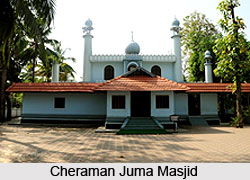 Cheraman Juma Masjid, situated in Kodungalloor region in Thrissur district of Kerala, is famed as the first mosque in India. It was built by Malik lbn Dinar in 629 AD. In the 11th century, the mosque underwent renovation and reconstruction for the first time. The mosque is enlisted among the most significant mosques of India and invites devotees from far off regions. It allows the entry of people belonging to all religions without any restrictions. The mosque also hosts the non Muslim ceremony `Vidhyarambham` of children which is the initiation ceremony to the world of letters. Cheraman Juma Masjid also played a vital role in the propagation of Islam in India.
Cheraman Juma Masjid, situated in Kodungalloor region in Thrissur district of Kerala, is famed as the first mosque in India. It was built by Malik lbn Dinar in 629 AD. In the 11th century, the mosque underwent renovation and reconstruction for the first time. The mosque is enlisted among the most significant mosques of India and invites devotees from far off regions. It allows the entry of people belonging to all religions without any restrictions. The mosque also hosts the non Muslim ceremony `Vidhyarambham` of children which is the initiation ceremony to the world of letters. Cheraman Juma Masjid also played a vital role in the propagation of Islam in India.
History of Cheraman Juma Masjid
Kerala Vyasan Kunhikuttan Thampuran opines that ages ago a portion of land was gifted to the Muslims for establishing a mosque. Trade relations of the Indian subcontinent with Arabia was active since ancient times and Arab traders used to visit the Malabar region, the major link between the ports of South India and Southeast Asia, even before the establishment of Islam in Arabia. After Islam emerged as a prominent religion in Arabia, it also found its way to India through the Arab merchants who carried this new religion to various places for its propagation. This posed a great impact on the Indian dwellers in the coastal areas of Kerala who converted to Islam after accepting the principles of this new religion.
A popular historic event marks the conversion of the Brahmin king Cheraman Perumal, who was the first Indian who adopted Islam. The event took place when a group of Islamic prophet Muhammad`s companions visited Kodungallur. During their visit, the king witnessed an astounding incident which was the `splitting of the moon`, celebrated as the miracle of Muhammad. After enquiring about the same, the king came to know that the phenomenon symbolized the arrival of a messenger of God from Arabia. Subsequently, he travelled to Makkah and converted to Islam, adopting the name Thajudeen. However he died on his way back to India at Salalah in the Sultanate of Oman. Before succumbing to death he authorized a few of his Arab companions to take up the task of spreading Islam in his kingdom. Consequently, a group of Arabs under the leadership of Malik bin Habib and Malik Bin Deenar reached north Kerala and built a mosque at Kodungalloor region of Kerala. Since king Cheraman had sponsored the construction of the mosque, it was named as Cheraman Juma Masjid.
Architecture of Cheraman Juma Masjid
Cheraman Juma Masjid exhibits an impressive traditional Hindu style of architecture and was built using brass oil lamps, which is usually seen in Hindu temples. The pulpit which serves as the place of the recitation of the Friday sermon by Imam is made of rosewood featuring beautiful carvings. The mosque also houses a block of white marble which is believed to have been brought from Makkah or Mecca. There is a thousand years old oil lamp which always remains lighted in the mosque. The mosque also has two tombs, one of Malik Bin Deenar and the other one of his sister where incense sticks are lighted by the Muslim priest, an exemplary of another Hindu practice. Thus the mosque also signifies a strong bondage between the Hindus and the Muslims which forms the foundation of the secularity of the state.











